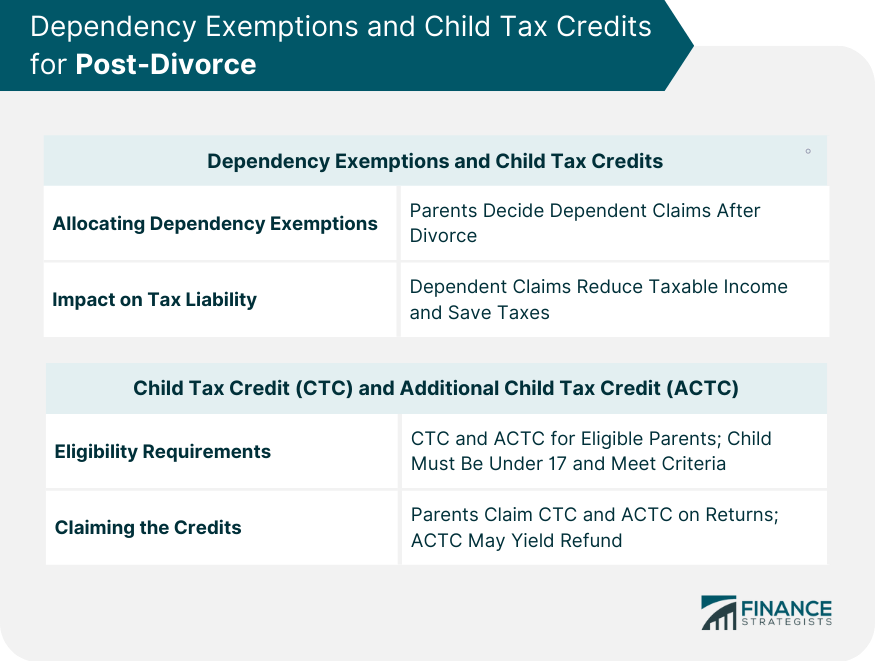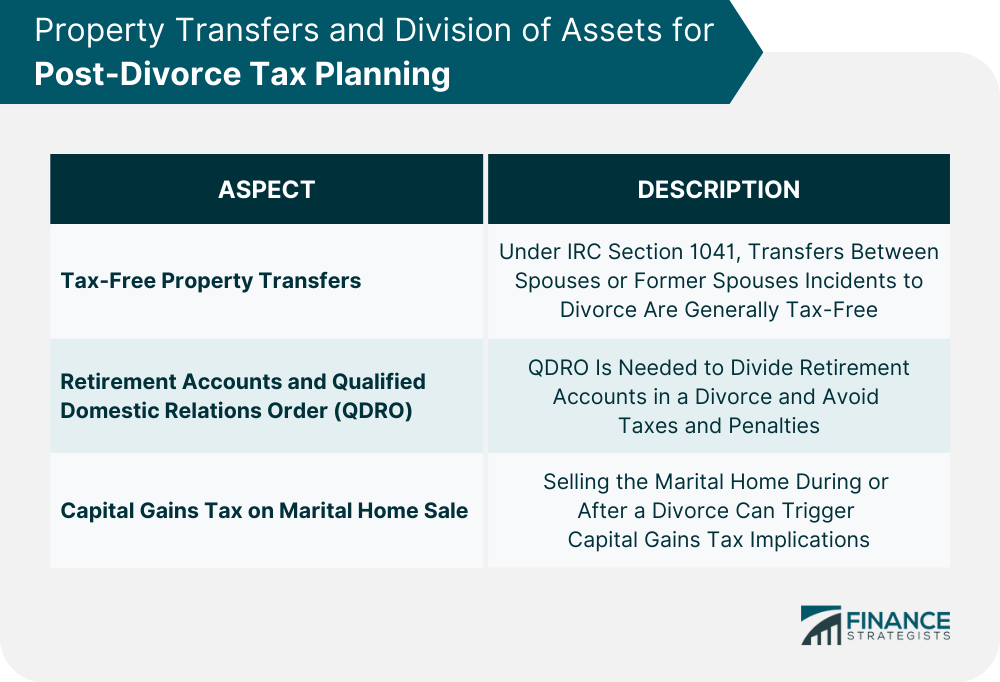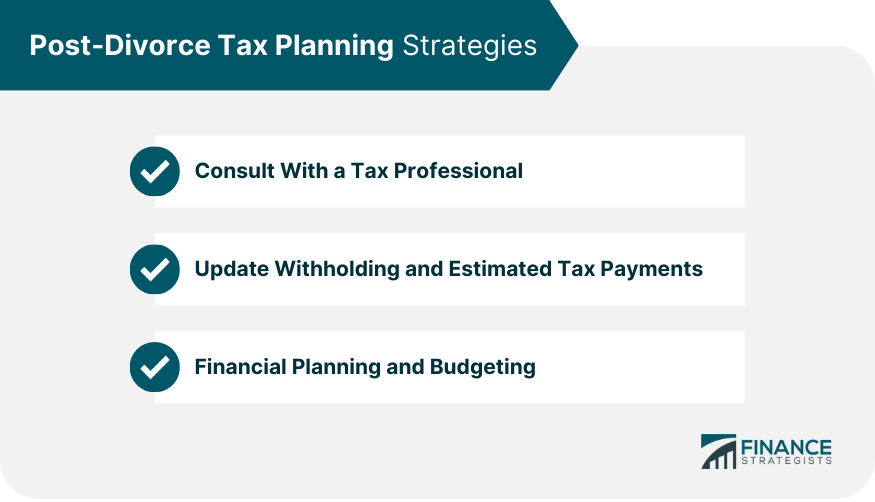Post-divorce tax planning is the process of understanding and addressing the tax implications that arise after a divorce. The goal of post-divorce tax planning is to optimize your financial circumstances, minimize tax liability, and ensure compliance with tax laws as you transition to your new life after divorce. After a divorce, financial situations and tax obligations can change drastically. Proactive tax planning is essential to ensure that both parties understand their new tax obligations and make informed decisions to optimize their financial situation. Divorce can result in various tax implications, including changes in filing status, dependency exemptions, and potential alimony payments. Being aware of these changes can help individuals avoid surprises and plan for their new financial reality. After a divorce, individuals typically transition to a single filing status, which can affect their tax brackets, deductions, and credits. Understanding the implications of this new status can help individuals plan and budget for their new financial circumstances. The head of household filing status offers a more favorable tax rate and a higher standard deduction compared to the single filing status. To qualify, an individual must be unmarried, pay more than half the cost of maintaining a home, and have a qualifying person live with them for more than half the year. Filing as head of household can provide significant tax savings for eligible individuals, as it offers lower tax rates and a higher standard deduction. This can result in reduced tax liability and increased financial stability after divorce. Dependency exemptions can significantly impact tax liability. After a divorce, parents must determine which parent will claim the child as a dependent. Generally, the custodial parent claims the exemption, but this can be modified through a written agreement or court order. Claiming a child as a dependent can result in significant tax savings, as it reduces the parent's taxable income. Understanding the impact of dependency exemptions on tax liability can help parents make informed decisions and optimize their financial situations. The Child Tax Credit (CTC) and Additional Child Tax Credit (ACTC) can provide valuable tax savings for eligible parents. To qualify, a child must be under 17 years old, claimed as a dependent, and meet certain residency and support requirements. Parents can claim the CTC and ACTC on their tax returns to reduce their tax liability. In some cases, the ACTC can result in a refund even if the parent does not owe any taxes. Understanding the process for claiming these credits can help parents maximize their tax savings. Under Internal Revenue Code Section 1041, property transfers between spouses or former spouses incident to divorce are generally tax-free. It is essential to understand the requirements and potential exceptions to avoid unexpected tax consequences. When dividing retirement accounts in a divorce, a Qualified Domestic Relations Order (QDRO) is needed to avoid taxes and penalties. A QDRO allows for the tax-free transfer of retirement assets between spouses, ensuring a fair division without tax implications. Selling the marital home during or after a divorce can trigger capital gains tax implications. Understanding the tax implications, including potential exclusions, can help both parties make informed decisions and minimize their tax liability. Child support payments are not tax-deductible for the payer and are not considered taxable income for the recipient. Understanding the tax treatment of child support is essential for accurate tax planning and compliance. The non-taxable nature of child support payments can impact both the payer and the recipient's financial situations. It is crucial for both parties to consider this when planning their post-divorce finances and tax obligations. To optimize the tax implications of child support, both parties can employ various tax planning strategies. These may include adjusting withholding amounts, claiming applicable tax credits, and considering the financial impact of child support payments on their overall tax situation. Some legal and professional fees related to a divorce may be tax-deductible. Understanding the eligibility criteria and limitations for deducting these expenses can help individuals minimize their tax liability and maximize their deductions. Divorced parents may still be eligible to claim education credits for their children's qualified education expenses. Understanding the eligibility requirements and claiming process can help parents optimize their tax savings and support their children's education. Medical expenses for both the individual and their dependents can be deductible, subject to certain limitations. Familiarizing oneself with these limitations and understanding the claiming process can help divorced individuals maximize their deductions and minimize their tax liability. A tax professional can provide valuable guidance and advice for navigating the complex tax implications of divorce. By consulting with a tax expert, individuals can ensure they are optimizing their tax situation and making informed decisions. After a divorce, it is crucial to update withholding amounts and estimated tax payments to reflect the new financial situation. This can help individuals avoid underpayment penalties and ensure they are paying the correct amount of taxes throughout the year. Post-divorce financial planning and budgeting are essential for maintaining financial stability and ensuring a smooth transition to a new financial reality. By creating a comprehensive financial plan, individuals can set themselves up for success and minimize the potential for financial stress. Post-divorce tax planning is crucial for optimizing one's financial circumstances, minimizing tax liability, and ensuring compliance with tax laws. Understanding changes in filing status, dependency exemptions, and child tax credits can help individuals make informed decisions to maximize their tax savings. Tax-free property transfers under IRC Section 1041, Qualified Domestic Relations Orders (QDRO), and capital gains tax on the sale of the marital home also require careful consideration. Child support payments are not tax-deductible for the payer and are not considered taxable income for the recipient, requiring both parties to consider their financial situations. Deductibility of legal and professional fees, claiming education credits, and medical expense deductions can also reduce tax liability. Consultation with a tax professional, updating withholding and estimated tax payments, and financial planning and budgeting can ensure a smooth transition to a new financial reality.What Is Post-Divorce Tax Planning?
Tax Filing Status Post-Divorce
Single Filing Status
Head of Household Status
Dependency Exemptions and Child Tax Credits
Allocating Dependency Exemptions
Eligibility Criteria
Impact on Tax Liability
Child Tax Credit and Additional Child Tax Credit
Eligibility Requirements
Claiming the Credits

Property Transfers and Division of Assets for Post-Divorce Tax Planning
Tax-Free Property Transfers Under IRC Section 1041
Retirement Accounts and Qualified Domestic Relations Orders (QDRO)
Capital Gains Tax on the Sale of the Marital Home

Tax Implications of Child Support
Child Support and Taxability
Impact on the Payer and Recipient
Tax Planning Strategies
Post-Divorce Tax Deductions and Credits
Deductibility of Legal and Professional Fees
Claiming Education Credits
Medical Expense Deductions
Post-Divorce Tax Planning Strategies

Consultation with a Tax Professional
Updating Withholding and Estimated Tax Payments
Financial Planning and Budgeting
Final Thoughts
Post-Divorce Tax Planning FAQs
Post-divorce tax planning is crucial for understanding the tax implications that arise after a divorce, such as changes in filing status, dependency exemptions, alimony, and property transfers. By addressing these issues proactively, you can optimize your financial situation, minimize your tax liability, and ensure compliance with tax laws.
Post-divorce tax planning can help you determine the most advantageous filing status, such as single or head of household. Choosing the appropriate filing status can result in lower tax rates and higher standard deductions, ultimately reducing your tax liability.
Post-divorce tax planning helps you navigate the allocation of dependency exemptions and claiming of child tax credits, both of which can significantly affect your tax liability. By understanding the eligibility criteria and processes involved, you can maximize your tax savings and make informed decisions for you and your children's financial well-being.
Post-divorce tax planning can help you understand the tax implications of alimony payments and property transfers, such as the tax treatment of alimony under recent law changes or the tax-free nature of property transfers under IRC Section 1041. By addressing these issues, you can minimize your tax liability and ensure a fair division of assets.
Professional guidance in post-divorce tax planning can help you navigate the complex tax landscape, identify potential tax savings, and ensure compliance with tax laws. By working with a tax professional, you can optimize your tax situation, make informed decisions, and set yourself on the path to financial stability and success in your post-divorce life.
True Tamplin is a published author, public speaker, CEO of UpDigital, and founder of Finance Strategists.
True is a Certified Educator in Personal Finance (CEPF®), author of The Handy Financial Ratios Guide, a member of the Society for Advancing Business Editing and Writing, contributes to his financial education site, Finance Strategists, and has spoken to various financial communities such as the CFA Institute, as well as university students like his Alma mater, Biola University, where he received a bachelor of science in business and data analytics.
To learn more about True, visit his personal website or view his author profiles on Amazon, Nasdaq and Forbes.













